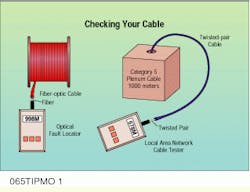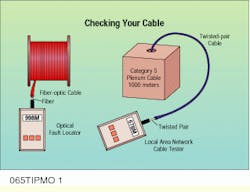Check your cable on the reel or in the box
Paul Andres, Mod-Tap Inc.
Problem
Suppose you pull an optical-fiber or copper cable run, terminate it and test it. Finding the run faulty, you determine the problem is not with the terminations but with the cable, itself. Was the cable faulty to begin with--in which case you can invoke the cable manufacturer`s guarantee--or was it damaged during pulling? At this point, there is no way to be certain enough about liability to convince the cable manufacturer to honor the warranty and replace the cable.
Solution
Although cable manufacturing has greatly improved in the past few years, it is still possible to receive damaged or short shipments. The best way to avoid this problem is to test the cable while it is still on the reel or in the pull-box.
Procedure
1) For optical-fiber cable, connect an optical fault locator (or optical time-domain reflectometer) to a fiber at the free end of the cable while it is still on the reel. Take a distance measurement. The distance measured should be close to that listed as the length of the cable on the reel. If the distance is shorter, the cable is shorter than advertised or there is a break in it. In either case, replace the cable.
2) For copper twisted-pair cable, attach a local area network cable tester to a pair at the free end of the cable while it is on the reel or in the box. Use the length function to determine the length of the cable. If the tester has no length function, measure the distance to an open circuit;
this should be the length of the cable, unless it is broken at midspan.
3) If you doubt the reading you have obtained, attach your test instrument to another fiber or pair in the same cable and repeat the length test.
An optical fault locator gives a length measurement for fiber cable on the reel (left); a local area network cable tester (right) provides a similar measurement for copper cable in a pull-box.
Paul Andres is a principal and managing director, Asia-Pacific, at Mod-Tap Inc., Harvard

